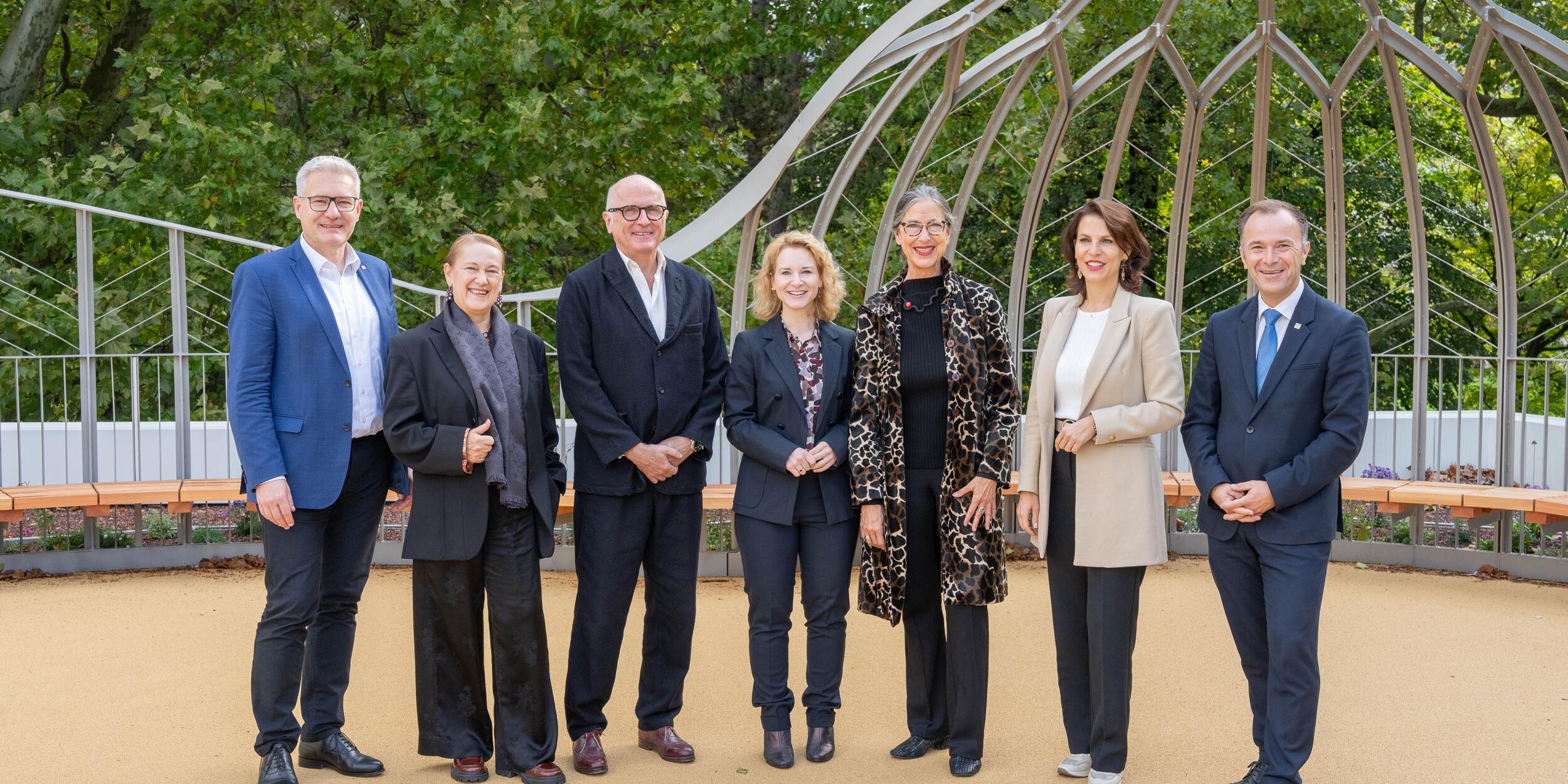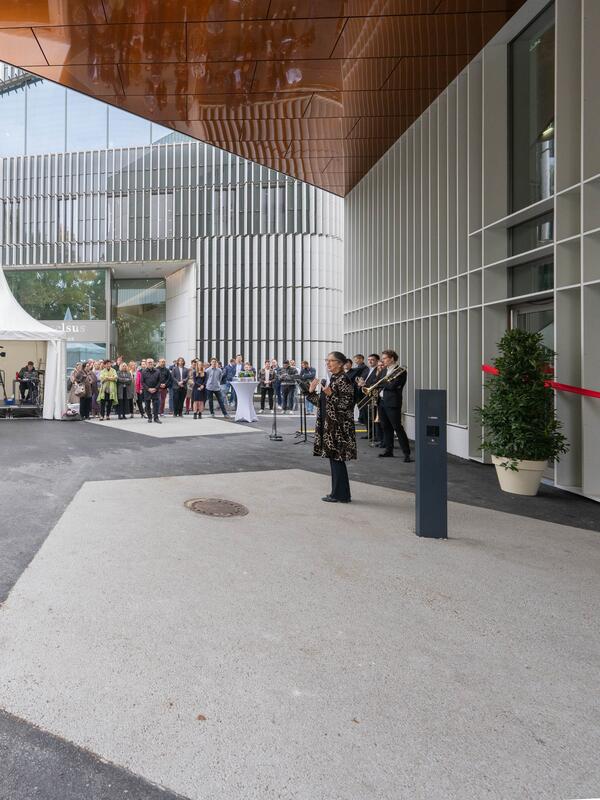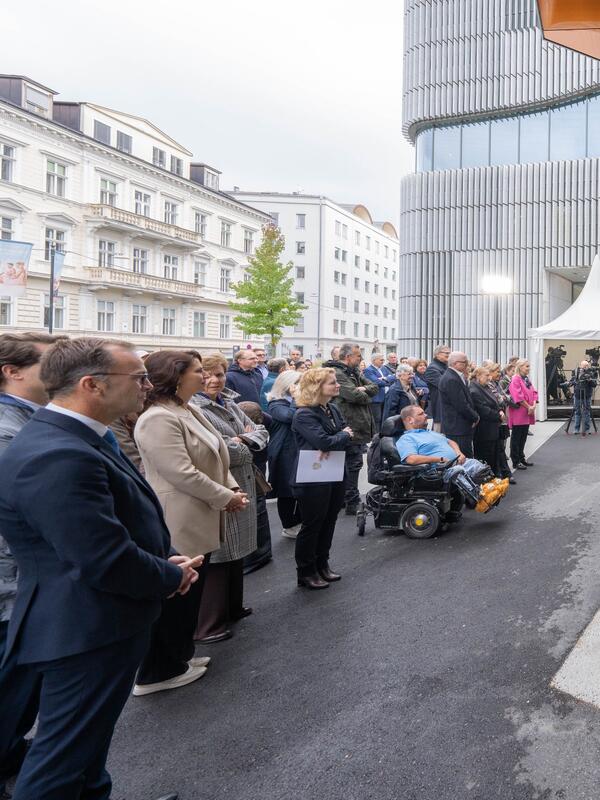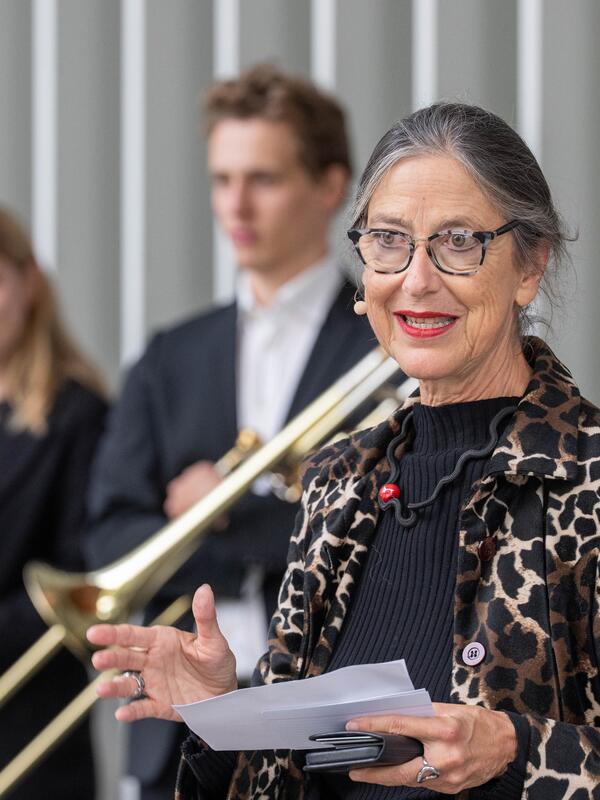Grand opening of the new Mozarteum University building "UMAK"

We are proud to announce that, after two and a half years of construction work, the Mozarteum University’s newest building, located in Schwarzstraße 36, is now complete and officially open! This exciting new space, with a surface area of 1,895m2, is dedicated to teaching, rehearsing, research, advancement and appreciation of the arts, and digital arts.
Photo (from l to r): Gregor Faistauer (Bachchor Salzburg), Tiina Parkkinen, Alfred Berger (architects), Bundesministerin Eva-Maria Holzleitner, Rector Elisabeth Gutjahr, Governor of Salzburg: Karoline Edtstadler, Mayor of Salzburg: Bernhard Auinger
A new chapter in the history of the Mozartuem University began this week with the opening of the new building “Universität Mozarteum am Kurgarten” (UMAK). This state-of-the-art project is a sustainable investment in the future of the advancement and appreciation of the Arts, artistic research, and Salzburg as a university city. Not only do its bright and spacious teaching, ensemble and rehearsal rooms provide a home for vocal and choral pedagogy, it also houses the X-Reality-Lab. This futuristic facility, which will be the first of its kind in Austria when it opens in spring 2026, enables students and professionals to experiment with AR, VR and AI, creating pictorial, video and sound worlds. Last but not least, UMAK provides a new home for the Mozarteum University’s Studio for Electronic Music and the Bachchor Salzburg.
Rector Elisabeth Gutjahr is delighted with the results. “UMAK opens up like a resonant architecture: the gentle sweep of its galleries, the shifting light, the distinctive materiality of floors, walls and doors, and the dramaturgy of its spaces. From the origins of music – the human voice and song – to highly complex, innovative technology, the building embodies what an Arts University stands for today: space for the advancement and appreciation of the arts, for research, for encounter and collaboration, and for new insights.”
Design and Construction
The UMAK is part of an urban design that ties in with the Baroque, Gründerzeit and 20th century architecture of the surrounding area, while also striving to create a connection between the Kurpark and the bustling cityscape. To this end, the UMAK is divided into two structures whose cascading height and size build a visual bridge between the closed development of the Auerspergstraße and the open structure on Schwarzstraße. Thanks to the clear, instantly identifiable architectural language, the UMAK, together with the Paracelsus Baths, will in future form a focal point at the historic heart of the city of Salzburg. The design paid particular attention to the form and layout of the Kurgarten, with its former fortifications and the accentuation of open spaces. The comings and goings of a large student population, along with the stream of visitors to the baths and spa house, should lead to a sustainable revitalisation of the northwestern area of the Kurgarten.
The new building was planned by the architects BERGER PARKKINEN +. The UMAK is part of an urban design concept that brings together architectural styles of the Baroque, Gründerzeit and 20th century architecture. To this end, the UMAK is divided into two structures whose cascading height and size build a visual bridge between the surrounding built environment. At the heart of the new building is an atrium that extends to the top floor and floods the interior with natural light. By dividing the building into two main sections, the architects were able to create an ingenious solution to accommodate the height differences between the large halls and practice rooms.
The modern, sustainable, and accessible university building, which took two and a half years to complete, is constructed from reinforced concrete (the majority of it recycled) and conforms to the klimaaktiv Silver Standard. This building certification is based on prescribed criteria in the areas of energy efficiency and performance, quality of building materials and construction, location, comfort, and health. For the users of the building, this means low heating and operating costs, excellent indoor air quality, and a comfortable ambience.
From planning and architecture to the contractors’ work on the technical and structural elements, finishes, fittings, and furnishings, around 50 companies—mostly from the Salzburg region or neighbouring provinces—were involved in the construction of the Universität Mozarteum am Kurgarten.
Brigitta Pallauf, President of Salzburg’s Regional Parliament, explained the significance of the new building for the region: “With around 2,000 students from 70 different countries, the Mozarteum is much more than just a university; it is a cultural flagship for Salzburg and makes an enormous contribution to the international life of our region. The financial support awarded by the Province of Salzburg for the development of this 2,400 m² university centre for vocal pedagogy, choral activities, the Digital Arts Forum, and research management amounts to €3.7 million. Our goal with this investment in the future of the arts, culture, and education is to strengthen the international reputation of the Mozarteum and Salzburg as one of the world’s leading university cities.”
Bernhard Auinger, Mayor of Salzburg, is equally enthusiastic about the role the new university building will play in the life of the city: “The new Mozarteum building in the Kurgarten is of fundamental importance for the city of Salzburg as a centre of culture, research, and innovation. This is a space where forward-looking topics across a wide variety of cultural areas can be researched and explored. The UMAK is an enormous asset to the cultural diversity of the city of Salzburg and also provides a new home for the Bach Choir. I congratulate everyone involved in the implementation of this unique project.”
The new building has also attracted attention at the national level. Eva-Maria Holzleitner, Minister for Women, Science, and Research, acknowledged its potential as a place for young people’s personal and professional development: “This new building is much more than just additional space: it is a place for learning, research, and creativity. A place where young people not only acquire knowledge but also develop their posture and find their voice—both literally and figuratively. This building stands for openness—architecturally, intellectually, and socially.”
Costs & Financing
The total budget amounts to €22.3 million. The Federal Ministry for Women, Science and Research is contributing the lion's share of €15.4 million, while the state of Salzburg is providing €3.7 million. This state contribution consists of €2.5 million in state funding, €0.5 million for science and innovation strategy, and €0.7 million for space for the Bach Choir. The Mozarteum University is financing €2.1 million from its own funds. The City of Salzburg and the Bach Choir Salzburg are jointly financing €1.1 million.
In addition, the Mozarteum University Salzburg will receive additional funding of €2.5 million for the X-Reality Lab from the Austrian Research Promotion Agency. The R&D infrastructure funding supports projects for the acquisition and development of high-quality R&D infrastructure for basic research and application-oriented research.
The facts at a glance
- Client and owner of the building: Mozarteum University Salzburg, land leased under building rights from the City of Salzburg
- Architecture: BERGER PARKKINEN +
- Usable floor space: 1,895 m2
- The space is spread over the ground floor and four additional levels, with a kitchen and offices on the ground floor and teaching rooms, rehearsal rooms and offices on the other levels. All levels are equipped with sanitary facilities and lifts. Level 5 features an inviting terrace for relaxation and events.
- Rooms: Teaching rooms, practice rooms, offices, project rooms, dedicated room for voice training, seminar room, choir rehearsal space, X-Reality Lab with adjoining rooms, electronic music studio
Load-bearing structure: Reinforced concrete construction - Sustainability: klimaaktiv building standard silver, predominant use of recycled concrete, district heating, cooling via heat pumps, decentralised humidification
- Gross investment costs including equipment: around €25.1 million, including €2.5 million in R&D infrastructure funding
- Construction period: February 2023 to July 2025
The Mozarteum University
The Mozarteum University is an arts university whose history dates back to 1841 and which was founded in the name of Wolfgang Amadeus Mozart. Now represented across 13 locations, it offers more than 2,200 students and 550 faculty members from around the world a comprehensive range of study and research opportunities in 15 departments and 7 institutes, covering the fields of music, theatre, scenography, open arts, artistic research, and music, dance and art education. With over 800 public events each year – ranging from concerts, operas and theatre performances to symposia, conferences, exhibitions and interdisciplinary performances – the Mozarteum University makes a substantial contribution to the cultural life and quality of life in the cities of Salzburg and Innsbruck.


